france
1562, Royal France, Charles IX. Beautiful Gold Ecu Coin. Paris mint! NGC AU-58
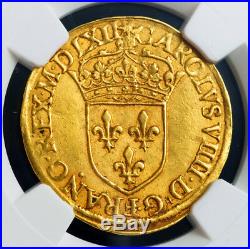
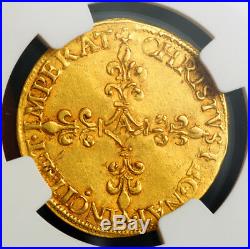
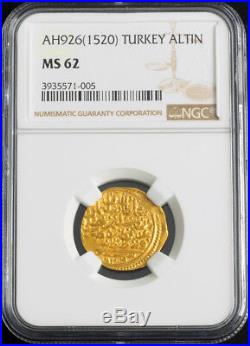
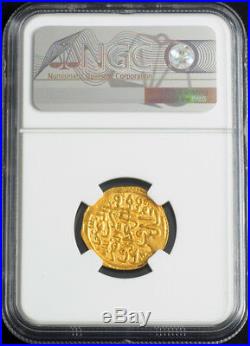

1562, Royal France, Charles IX. Beautiful Gold Ecu Coin. Mint Year: 1562 Mint Place: Paris (A) Reference: Friedberg 378, Duplessy 1057. Certified and graded by NGC as AU-58! Denomination: Gold Ecu (Écu d’or au soleil, 1st type) Diameter: 23mm Material: Gold! Obverse: Sun above crowned coat-of-arms with three lis inside (royal french arms). Charles IX, by the grace of God, king of the French. Reverse: Floriated cross with mint initial (A) in the middle. Christ reigns and commands! Charles IX (27 June 1550 30 May 1574) born Charles-Maximilien , was King of France, ruling from 1560 until his death. He is best known as king at the time of the St. Bartholomew’s Day Massacre. After the death of his elder brother, François II, in 1560, he inherited the throne and was crowned King of France in 1560 in the cathedral at Reims. The politics of that era were greatly influenced by his mother, Catherine de’ Medici, who was regent for the ten-year-old Charles, and by the power of the opposing religious faction leaders; the Protestant-leaning House of Bourbon and the ultra-Catholic House of Guise. The first of the French Wars of Religion broke out in 156263 when armed Protestant troops seized many French cities following an attack on Protestant worshippers by retainers of the Duke of Guise. After a four-year period of peace, an attempt by Huguenot armies at Meaux to capture and control the king led to the Second War of Religion from 1567 to 1568. A third war raged chiefly in south-western France from 1568 to 1570 with foreign intervention. On 26 November 1570 Charles married Elisabeth of Austria. They had one daughter, Marie-Elisabeth (27 October 1572 9 April 1578). Charles IX also had an illegitimate son, the duc d’Angoulême, with his mistress, Marie Touchet. In 1572, Charles IX witnessed the massacre of thousands of Huguenots (Protestants) in and around Paris in what became known as the St. Bartholomew’s Day massacre. Charles IX did not long survive the Massacre. He had always been fragile, both emotionally and physically: emotionally, his moods now swung from coarse boasting about the extremity of the Massacre, to claims that the screams of the murdered Huguenots kept ringing in his ears. Frantically he blamed his mother: Who but you is the cause of all of this? God’s blood, you are the cause of it all! The Queen-mother responded by declaring she had a lunatic for a son. Physically, Charles had never been strong, tending towards tuberculosis. The strain following the Massacres weakened his body to the point where, by spring of 1574, the hoarse coughing turned bloody and the hemorrhages grew more violent. He became bedridden and delusional. On his last day, 30 May 1574, at the Château de Vincennes, Val-de-Marne, Charles called for Henry of Navarre, embraced him, and said, Brother, you are losing a good friend. Had I believed all that I was told, you would not be alive. But I always loved you… I trust you alone to look after my wife and daughter. Pray God for me. Charles was not yet twenty-four years old. The crown of France now passed to his brother, Henry III. The item “1562, Royal France, Charles IX. Beautiful Gold Ecu Coin. Paris mint! NGC AU-58″ is in sale since Tuesday, October 2, 2018. This item is in the category “Coins & Paper Money\Coins\ World\Gold”. The seller is “coinworldtv” and is located in Europe. This item can be shipped worldwide.
- Certification Number: 3935960-003
- Certification: NGC
- Grade: AU58
- Composition: Gold

France Medieval Rare Gold French Coin Of The Middle Ages 1364-1380 Charles V
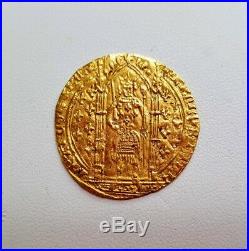
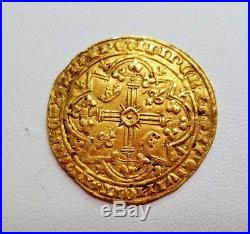
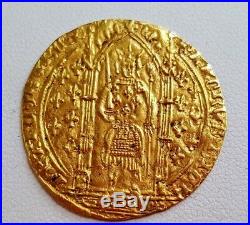
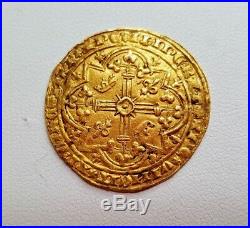
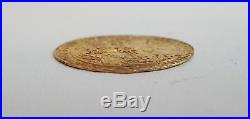

FRANCE MEDIEVAL RARE GOLD FRENCH COIN OF THE MIDDLE AGES. JUST OUT OF A SAFE DEPOSIT BOX FROM AN ESTATE BEING LIQUIDATED. A KIND EBAYER TOLD US. FOUND IN AN OLD ENVELOPE WRITTEN. FRENCH MEDIEVAL GOLD COIN, ORIGINAL. ABOUT 1 1/8 WIDE. THE WEIGHT IS 3.76 GRAMS. THAT’S ALL WE KNOW. We do not know those charges throughout the world. Feedback: We are happy to leave feedback for our customers. We would appreciate that once you receive your item, you also leave us feedback. If you feel that you cannot leave a Positive comment with all 5 stars – I WILL EARN IT. Please do not hesitate to contact me for any reason. The item “FRANCE MEDIEVAL RARE GOLD FRENCH COIN OF THE MIDDLE AGES 1364-1380 CHARLES V” is in sale since Wednesday, June 20, 2018. This item is in the category “Coins & Paper Money\Coins\ World\Gold”. The seller is “antiqer41″ and is located in Clinton, New York. This item can be shipped worldwide.
- Certification: Uncertified
- Composition: Gold

France 20 Francs Napoleon III Gold Coin Random Date Average Circulated
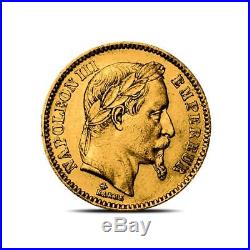
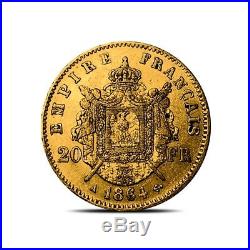
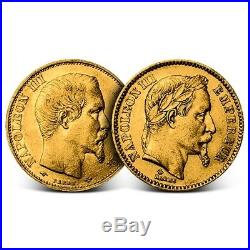
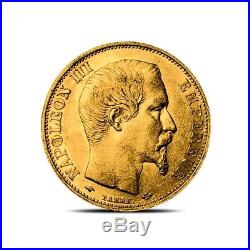

France 20 Francs Napoleon III Gold Coin – Random Date – Average Circulated. Obverse There are two versions of the Napoleon III 20 Franc: the Bare Head and the Laureate Head. Both display a portrait of Napoleon III, but the latter shows the emperor wearing a wreath. The inscriptions &###x201C;NAPOLEON III EMPEREUR&###x201D; appear at the edge along the name &###x201C;BARRE&###x201D; as a nod to the coin&###x2019;s designer. The Bare Head style was struck from 1852 to 1860, while the laureate edition was made from 1861 to 1870. Reverse When the portrait of Napoleon was modified in 1861, the coin&###x2019;s reverse underwent a redesign too. The 1852 to 1860 Bare Head version features a wreath with the country of origin (&###x201C;EMPIRE FRANCAIS&###x201D;) at the edge, along with the date and denomination in the center. The coin&###x2019;s mintmark is engraved at the bottom; A refers to the Paris Mint while BB is the mintmark of the Strasbourg facility. On the 1861 to 1870 edition, meanwhile, the wreath is replaced by the empire&###x2019;s coat of arms. About the Napoleon III 20 Franc Gold Coin The reign of Napoleon III was marked by turmoil, war, and controversy. One could argue that Napoleon III had the ambition and drive of his uncle (the famous Napoleon I), but lacked the same level of military and leadership skill. Nonetheless, the French ruler projected an image of power on this country&###x2019;s coinage. The 20 Franc proudly declared Napoleon III as the emperor. Even though France as a nation had its ups and downs in the mid-late 19th century, its 20 Franc gold pieces became one of the world&###x2019;s most popular coins. To this day, it remains a trusted and low-premium means of owning gold. At Provident, our primary goal is to make it simple and safe to invest in precious metals. We sell only genuine bullion products sourced directly from the mints that produce them, such as the US Mint, Royal Canadian Mint, Perth Mint, and more. In addition, our inventory holds a unique mix of products that you can only find at Provident. Additionally, our team is committed to offering exceptional customer service at every step of the investing process. You can rest easy knowing that you will get exactly what you ordered each and every time. All packages are fully insured during transit. Will I receive the exact item pictured? All photos are stock and are meant to represent the type and quality of item you will receive. What is spot price? Spot price is the market value of precious metals at a given point in time. How are prices calculated? Nearly all products in our store are priced at a premium or discount to the spot price. As spot price moves up and down throughout the day, so will the price of the product. How often are prices adjusted based on spot price? Similarly, our traders are NOT commissioned. What you see is what you get. Can I cancel my order? Cancellations are considered on a case-by-case basis. Is there a minimum order? There is no minimum order. Can I change my order once it has been placed? No changes can be made to the items included in an order once it has been placed, but a subsequent order can be placed. Yes, you can apply those monies at checkout. Will my order be insured? First off, we are sorry this happened. That said, it does happen, but we will make it right. We always do our best to do right by our customers. Not at this time. How long will my order take to get to me? View more great items. This listing is currently undergoing maintenance, we apologise for any inconvenience caused. The item “France 20 Francs Napoleon III Gold Coin Random Date Average Circulated” is in sale since Wednesday, June 6, 2018. This item is in the category “Coins & Paper Money\Bullion\Gold\Coins”. The seller is “providentmetals” and is located in Addison, Texas. This item can be shipped to United States.
- coin Diameter: 21mm
- composition: .900 Fine Gold
- mint: Foreign
- year: Various
- denomination: 20 Francs

1515, Royal France, Louis XII. Scarce Gold Ecu (for Dauphine!) Coin. NGC AU58
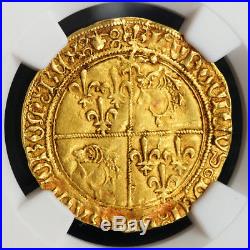
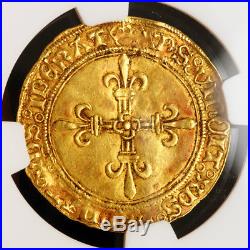
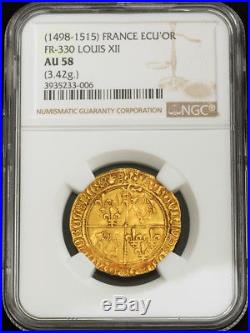
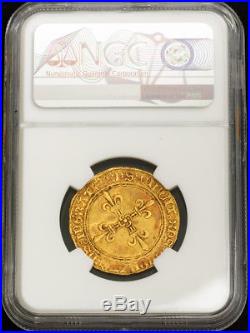

1515, Royal France, Louis XII. Scarce Gold “Ecu” for Dauphine! Certified and graded by NGC as AU-58! Denomination: Écu d’or au Soleio for Dauphine. Gold Ecu with sun, for Daupine. Weight: 3.42gm Material: Gold! Obverse: Circular quartered Arms of France (triple lis symbols) and the Province of Dauphiné (dolphins) with a sun at 12 o’cock. Legend: (lis symbol) LVDOVICVS °° DEI °° GRA °° FRANCOROM. Spelling error of the engraver: “FRANCOROM” instead of FRANCORVM! °° EX °° (privy mark) °°. Reverse: Cross patonce, with lis in center and at tips of cross. Legend: + XPS °° VINCIT °° XPS °° REGNAT °° XPS °° IPERAT. Spelling error of the engraver: “PERAT” instead of IMPERAT! The Dauphiné or Dauphiné Viennois is a former province in southeastern France, roughly corresponding to the present departments of the Isère, Drôme, and Hautes-Alpes. The historical capital is Grenoble and the main towns Vienne, Valence, Die, Gap and Briançon. Louis XI was the only king of France to reside in the Dauphiné for any length of time. In the 12th century, the local ruler Count Guigues IV of Albon c. 10951142 bore a dolphin on his coat of arms and was nicknamed le Dauphin (French for dolphin). His descendants changed their title from Count of Albon to Dauphin of Viennois. The state took the name of Dauphiné. Louis XII (27 June 1462 – 1 January 1515) was a monarch of the House of Valois who ruled as King of France from 1498 to 1515 and King of Naples from 1501 to 1504. The son of Charles, Duke of Orléans, and Maria of Cleves, he succeeded his cousin Charles VIII, who died without a living heir in 1498. Before his accession to the throne of France, he was known as Louis of Orléans and was compelled to be married to his handicapped and sterile cousin Joan by his uncle, king Louis XI. By doing so, Louis XI hoped to extinguish the Orléans cadet branch of the House of Valois. Louis of Orléans was one of the great feudal lords who opposed the French monarchy in the conflict known as the Mad War. At the royal victory in the Battle of Saint-Aubin-du-Cormier in 1488, Louis was captured, but Charles VIII pardoned him and released him. When Louis XII became king in 1498, he had his marriage with Joan annulled by Pope Alexander VI and instead married Anne of Brittany, the widow of his cousin Charles VIII. This marriage allowed Louis to reinforce the personal Union of Brittany and France. Louis persevered in the Italian Wars, initiating a second Italian campaign for the control of the Kingdom of Naples. Louis conquered the Duchy of Milan in 1500 and pushed forward to the Kingdom of Naples, which fell to him in 1501. Proclaimed King of Naples, Louis faced a new coalition gathered by Ferdinand II of Aragon and was forced to cede Naples to Spain in 1504. Louis XII did not encroach on the power of local governments or the privileges of the nobility, in opposition with the long tradition of the French kings to impose an absolute monarchy in France. A popular king, Louis was proclaimed ” Father of the People ” French. Le Pére du Peuple. Louis XII died in 1515 without a male heir. He was succeeded by his cousin Francis from the Angoulême cadet branch of the House of Valois. The item “1515, Royal France, Louis XII. Scarce Gold Ecu (for Dauphine!) Coin. NGC AU58″ is in sale since Sunday, June 24, 2018. This item is in the category “Coins & Paper Money\Coins\ World\Gold”. The seller is “coinworldtv” and is located in Europe. This item can be shipped worldwide.
- Certification Number: 3935233-006
- Certification: NGC
- Grade: AU58
- Composition: Gold

1364, Royal France, John II. Stunning Gold Cavalier Franc Coin. R! NGC MS-61
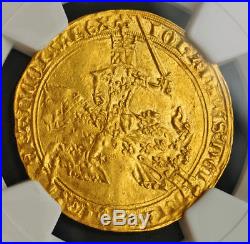
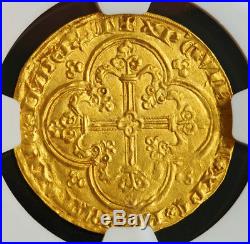
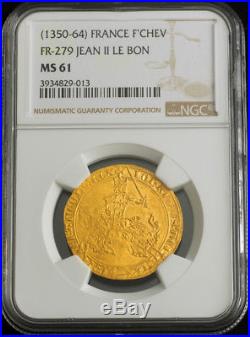
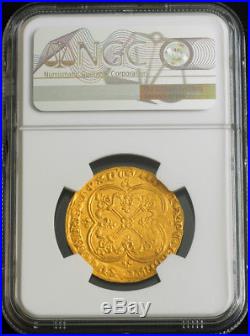

1364, Royal France, John II. Stunning Gold “Cavalier” Franc Coin. A very important milestone coin. The first of its type! Mint Place: Paris Mint year: 1360 (5th December) References: Duplessy 294, Friedberg 279. Certified and graded by NGC as MS-61! Ruler (King) : John II of France. (Jean le Bon) Denomination: Golden Rider Franc / Franc à cheval / Cavalier d’Or Material: Pure Gold! Diameter: 28mm Weight: 3.87gm. Obverse: Knight in full regalia, wielding sword, on galloping horse with mantle decorated with French royal arms (fleur-du-lis) mantle left. Legend: IOHANNES: DEI: GRACIA: FRANCORV: REX (lis). Reverse: Cross fleury within double quadrilobe frame. Legend: XPC VINCIT XPC REGNAT XPC IMPERAT +. The first Franc ever minted, the “Franc à cheval”, was minted upon Jean le Bon’s return from captivity from 5 December 1360, and featured combative imagery. This historic coin was issued in pure gold and its standard wieght was 3.73gm. It conveniently coincided with the account value of one livre tournois. A very rare and important coin! John II (16 April 1319 8 April 1364), called John the Good French. , was the King of France from 1350 until his death. He was the second sovereign of the House of Valois and is perhaps best remembered as the king who was vanquished at the Battle of Poitiers and taken as a captive to England. The son of Philip VI and Joan the Lame, John became the Count of Anjou, Count of Maine, and Duke of Normandy in 1332. He was created Count of Poitiers in 1344, Duke of Aquitaine in 1345, and Duke of Burgundy (as John I) from 1361 to 1363. By his marriage to Joanna I, Countess of Auvergne and Boulogne, he became. Count of Auvergne and Boulogne from 1350 to 1360. John succeeded his father in 1350 and was crowned at Notre-Dame de Reims. As king, John surrounded himself with poor administrators, preferring to enjoy the good life his wealth as king brought. Later in his reign, he took over more of the administration himself. John was nine years old when his father had himself crowned as Philip VI of France. His ascent to the throne was unexpected, and because all female descendants of his uncle Philip the Fair were passed over, it was also disputed. The new king had to consolidate his power in order to protect his throne from rival claimants. Philip therefore decided to marry off his son Johnthen thirteen years oldquickly to form a strong matrimonial alliance, at the same time conferring upon him the title of Duke of Normandy. Thought was initially given to a marriage with Eleanor, sister of the King of England, but instead Philip invited John of Luxembourg, King of Bohemia, to Fontainebleau. Bohemia had aspirations towards Lombardy and needed French diplomatic support. A treaty was drawn up. The military clauses stipulated that in the event of war Bohemia would support the French army with four hundred infantrymen. The political clauses ensured that the Lombard crown would not be disputed if the King of Bohemia managed to obtain it. Philip selected Bonne of Bohemia as a wife for his son as she was closer to child-bearing age (16 years), and the dowry was fixed at 120,000 florins. John came of age on 26 April 1332, and received overlordship of the duchy of Normandy, as well as the counties of Anjou and Maine. The wedding was celebrated on 28 July at the church of Notre-Dame in Melun in the presence of six thousand guests. The festivities were prolonged by a further two months when the young groom was finally knighted at the cathedral of Notre-Dame in Paris. Duke John of Normandy was solemnly granted the arms of a knight in front of a prestigious assistance bringing together the kings of Luxembourg and Navarre, and the dukes of Burgundy, Lorraine and the Brabant. In 1332, John became Duke of Normandy in prerogative, and had to deal with the reality that most of the Norman nobility was already allied with the English camp. Effectively, Normandy depended economically more on maritime trade across the English Channel than it did by river trade on the Seine. The Duchy had not been English for 150 years but many landowners had possessions across the Channel. Consequently, to line up behind one or other sovereign risked confiscation. Therefore the Norman nobility were governed as interdependent clans which allowed them to obtain and maintain charters guaranteeing the duchy a deal of autonomy. It was split into two key camps, the counts of Tancarville and the counts of Harcourtwhich had been in conflict for generations. Tension arose again in 1341. King Philip, worried about the richest area of the kingdom breaking into bloodshed, ordered the bailiffs of Bayeux and Cotentin to quell the dispute. Geoffroy d’ Harcourt raised troops against the king, rallying a number of nobles protective of their autonomy and against royal interference. The rebels demanded that Geoffroy be made duke, thus guaranteeing the autonomy granted by the charter. Royal troops took the castle at Saint-Sauveur-le-Vicomte and Geoffroy was exiled to the Brabant. Three of his companions were decapitated in Paris on 3 April 1344. By 1345 increasing numbers of Norman rebels had begun to pay homage to Edward III, constituting a major threat to the legitimacy of the Valois kings. The defeat at Crécy and the rendering of Calais further damaged royal prestige. Defections by the nobility increasedparticularly in the north and west whose land fell within the broad economic influence of England. Consequently King Philip decided to seek a truce. Duke John met Geoffroy d’ Harcourt, to whom the king agreed to return all confiscated goods; even appointing him sovereign captain in Normandy. John then approached the Tancarville family, whose loyalty could ultimately ensure his authority in Normandy. The marriage of John, Viscount of Melun to Jeanne, the only heiress of the county of Tancarville ensured the Melun-Tancarville party remained loyal to John, while Godefroy de Harcourt continued to act as defender for Norman freedoms and thus of the reforming party. In 1354, John’s son-in-law and cousin, Charles II of Navarre, who, in addition to his small Pyrenean kingdom, also held extensive lands in Normandy, was implicated in the assassination of the Constable of France, Charles de la Cerda. Nevertheless, to have a strategic ally against the English in Gascony, John signed the Treaty of Mantes with Charles on 22 February 1354. The peace did not last between the two and Charles eventually struck up an alliance with Henry of Grosmont, the first Duke of Lancaster. The next year (1355), John signed the Treaty of Valognes with Charles, but this second peace lasted hardly longer than the first. In 1355, the Hundred Years’ War flared up again. In July of 1356, the Black Prince, son of Edward III of England, took a small army on a. John pursued him with an army of his own. In September a few miles southeast of Poitiers, the two forces met. John was confident of victoryhis army was probably twice the size of his opponent’sbut he did not immediately attack. While he waited, the papal legate went back and forth, trying to negotiate a truce between the leaders. There is some debate over whether the Prince wanted to fight at all. He offered his wagon train, which was heavily loaded with loot. He also promised not to fight against France for seven years. Some sources claim that he even offered to return Calais to the French crown. John countered by demanding that 100 of the Prince’s best knights surrender themselves to him as hostages, along with the Prince himself. No agreement could be reached. Negotiations broke down, and both sides prepared for combat. On the day of the Battle of Poitiers, John and 19 knights from his personal guard dressed identically. This was done to confuse the enemy, who would do everything possible to capture the sovereign on the field. In spite of this precaution John was captured. Though he fought with valor, wielding a large battle-axe, his helmet was knocked off. Surrounded, he fought on until Denis de Morbecque, a French exile who fought for England, approached him. Yield yourself to me and I will lead you to the Prince of Wales. King John surrendered by handing him his glove. That night King John dined in the red silk tent of his enemy. The Black Prince attended to him personally. He was then taken to Bordeaux, and from there to England. Although Poitiers is centrally located, it is not known that anyonenoble or peasantattempted to rescue their king. While negotiating a peace accord, he was at first held in the Savoy Palace, then at a variety of locations, including Windsor, Hertford, Somerton Castle in Lincolnshire, Berkhamsted Castle in Hertfordshire and briefly at King John’s Lodge, formerly known as Shortridges, in East Sussex. A local tradition in St Albans is that he was held in a house in that town, at the site of the 15th-century Fleur de Lys inn, before he was moved to Hertford. There is a sign on the inn to that effect, but apparently no evidence to confirm the tradition. Eventually, John was taken to the Tower of London. As a prisoner of the English, John was granted royal privileges, permitting him to travel about and to enjoy a regal lifestyle. The Treaty of Brétigny (1360) set his ransom at 3 million crowns. Leaving his son Louis of Anjou in English-held Calais as a replacement hostage, John was allowed to return to France to raise the funds. But all did not go according to plan. In July of 1363, King John was informed that Louis had escaped. Troubled by the dishonour of this, and the arrears in his ransom, John did something that shocked and dismayed his people: he announced that he would voluntarily return to captivity in England. His council tried to dissuade him, but he persisted, citing reasons of good faith and honour. He sailed for England that winter and left the impoverished citizens of France again without a king. John was greeted in London 1364 with parades and feasts. A few months after his arrival, however, he fell ill with an unknown malady. He died at the Savoy in April 1364. John suffered from fragile health. He engaged little in physical activity, practised jousting rarely, and only occasionally hunted. Contemporaries report that he was quick to get angry and resort to violence, leading to frequent political and diplomatic confrontations. He enjoyed literature, and was patron to painters and musicians. The image of a “warrior king” probably emerged from the courage in battle he showed at Poitiers, and the creation of the Order of the Star. This was guided by political need as John was determined to prove the legitimacy of his crownparticularly as his reign, like that of his father, was marked by continuing disputes over the Valois claim from both Charles II of Navarre and Edward III of England. From a young age, John was called to resist the de-centralising forces which impacted upon the cities and the nobility; each attracted either by English economic influence or the reforming party. He grew up amongst intrigue and treason, and in consequence he governed in secrecy only with a close circle of trusted advisers. He took as wife Bonne of Bohemia, and fathered 10 children, in eleven years. Some historians also suggest a strong romantic and possibly homosexual attachment to Charles de la Cerda. La Cerda was given various honours and appointed to the high position of. When John became king; he accompanied the king on all his official journeys to the provinces. La Cerda’s rise at court excited the jealousy of the French barons, several of whom stabbed him to death in 1354. As such, La Cerda’s fate paralleled that of Edward II of England’s Piers Gaveston in England, and John II of Castile’s Alvaro de Luna in Spain; the position of a royal favourite was a dangerous one. John’s grief on La Cerda’s death was overt and public. The item “1364, Royal France, John II. Stunning Gold Cavalier Franc Coin. R! NGC MS-61″ is in sale since Thursday, June 21, 2018. This item is in the category “Coins & Paper Money\Coins\ World\Gold”. The seller is “coinworldtv” and is located in Europe. This item can be shipped worldwide.
- Certification Number: 3934829-013
- Certification: NGC
- Grade: MS61
- Composition: Gold

ON SALE! 20 Francs France Gold Coin Rooster (BU)
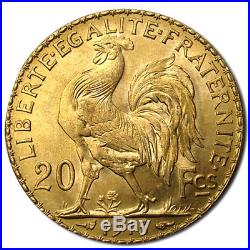
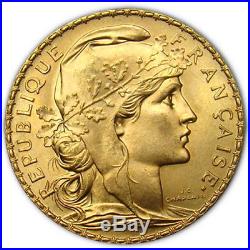

America the Beautiful Coins. New Zealand Silver Coins. Add JM Bullion to your favorite stores and receive our exclusive emails about new items and special promotions! 20 Francs France Gold Coin – Rooster (BU). One of the more amazing choices for modern-day investors and collectors is a historic French gold coin known as the Marianne Rooster design. Struck by the Paris Mint for the first time in 1899, the coins were not in circulation for long, and today those which remain in BU condition are a true treasure. Today, 20 Francs Gold Coins with the Marianne Rooster design are available to you online from JM Bullion. Arrives in protective plastic! Struck between 1899 and 1914! 1867 Troy oz of actual gold content. Face value of 20 Francs issued originally by France&###x2019;s government. Obverse includes the image of Marianne, a symbol of Liberty and reason. Reverse features the Gallic Rooster, the unofficial symbol of France. JM Bullion is one of the nation&###x2019;s leading online precious metals dealers, serving hundreds of thousands of customers since the company&###x2019;s inception in 2011. Operating as a lean online retailer, we are able to offer the lowest possible pricing on the most popular gold, silver, and platinum bullion items. Our labels, return address, and packaging do not give any indication of the valuable contents of the package, so you can rest assured that your packages will arrive safe and sound. When ordering from JM Bullion, you can be sure that your products are fully covered from our doorstep to yours. Is my financial and personal information secure? Yes, all personal information is transmitted using secure SSL web pages. These pages are encrypted to ensure that no personal, financial, or identifiable information is made available to anyone other than you, your bank, or the processor. Please note that even if you don? Will gold and silver go up in value? We cannot guarantee that gold or silver will go up in value. Like any investment, gold and silver can and will both increase and decrease over time. While we cannot guarantee that gold or silver will increase in value, history has proven its long term viability as an investment vehicle. How are your prices determined? Our prices are determined by the spot prices of gold and silver, in addition to our fixed premiums for each product. Our spot prices, provided by Xignite. Com, are accurate up to the second, and we add on our premium per ounce for each product to come up with the final price. T need to worry about items going out of stock or disappearing during a price update. Do you have minimum or maximum order sizes? Can I modify my order? Unfortunately order modifications require tremendous effort on our part, as our system is largely automated. Can I cancel my order? We begin to process your order as soon as it is completed, so unfortunately we cannot permit order cancelations. Attempting to do so typically results in pick and pack or billing errors, so we do not allow order cancelations. When will I receive my order? From there, the transit time depends on the carrier. Customers receive tracking numbers as soon as their orders queue up for pick and pack, so they can track their order from the time it leaves our facility until it arrives to their doorstep. Can you combine separate orders? What happens if my order is lost or damaged in transit? View more great items. This listing is currently undergoing maintenance, we apologise for any inconvenience caused. The item “ON SALE! 20 Francs France Gold Coin Rooster (BU)” is in sale since Friday, May 04, 2018. This item is in the category “Coins & Paper Money\Coins\ World\Gold”. The seller is “jmbullion” and is located in Las Vegas, Nevada. This item can be shipped to United States.
- Composition: Gold
- Shape: Coin
- Precious Metal Content: .1867

1547, Royal France, Francis I. Beautiful Gold Ecu (with Sun) Coin. NGC MS-61
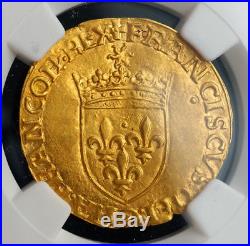
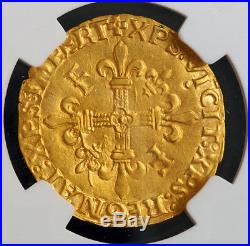
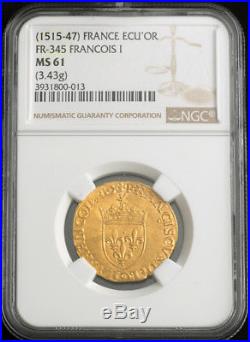
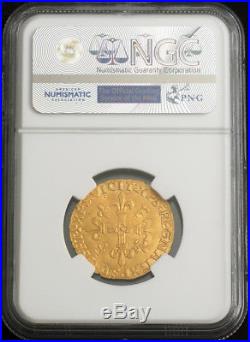

1547, Royal France, Francis I. Beautiful Gold Ecu (with Sun) Coin. Mint Year: 1519 References: Friedberg 345, Duplessy 775. Certified and graded by NGC as MS-61! Denomination: Ecu d’or au soleil. Gold Ecu with Sun. 5th type Diameter: 36mm Weight: 3.43gm Material: Gold! Obverse: Sun above crowned shield with french royal arms (three lis). Reverse: Ornate cross with fleur de lis terminals and rosette center. Two lis and two large letters F (for Francois) in fields. Legend: + XPS : VICIT : XPS : REGNAT : XPS : IMPERT. Francis I (French: François Ier ; 12 September 1494 31 March 1547), was king of France from 1515 until his death. Francis I is considered to be France’s first Renaissance monarch. His reign saw France make immense cultural advances. He was a c ontemporary of Suleiman the Magnificent of the Ottoman Empire, with whom he was allied in a Franco-Ottoman alliance, as well as of Henry VIII of England and of Holy Roman Emperor Charles V, his great rivals. Francis’ legacy is generally considered a mixed one. He achieved great cultural feats, but they came at the expense of France’s economic well-being. The persecution of the Protestants was to lead France into decades of civil war, which did not end until 1598 with the Edict of Nantes. The item “1547, Royal France, Francis I. Beautiful Gold Ecu (with Sun) Coin. NGC MS-61″ is in sale since Saturday, November 04, 2017. This item is in the category “Coins & Paper Money\Coins\ World\Gold”. The seller is “coinworldtv” and is located in Europe. This item can be shipped worldwide.
- Certification: NGC
- Certification Number: 3931800-013
- Grade: MS61

- ← Previous
- 1
- 2